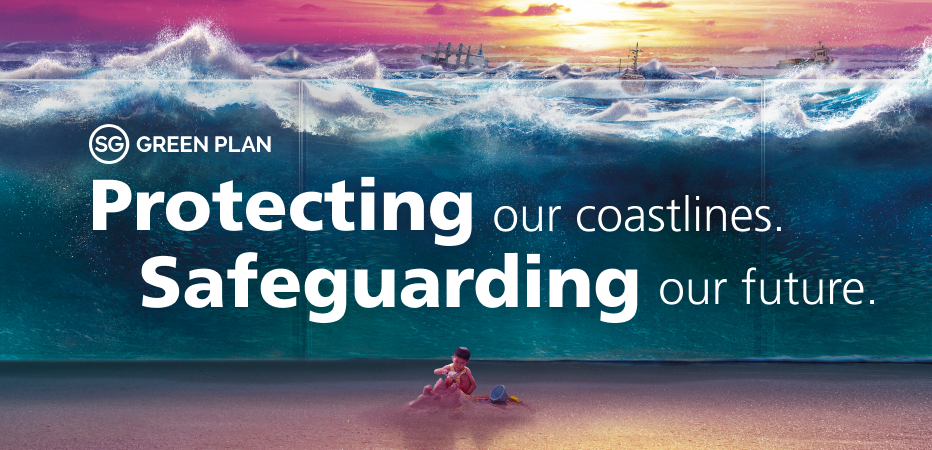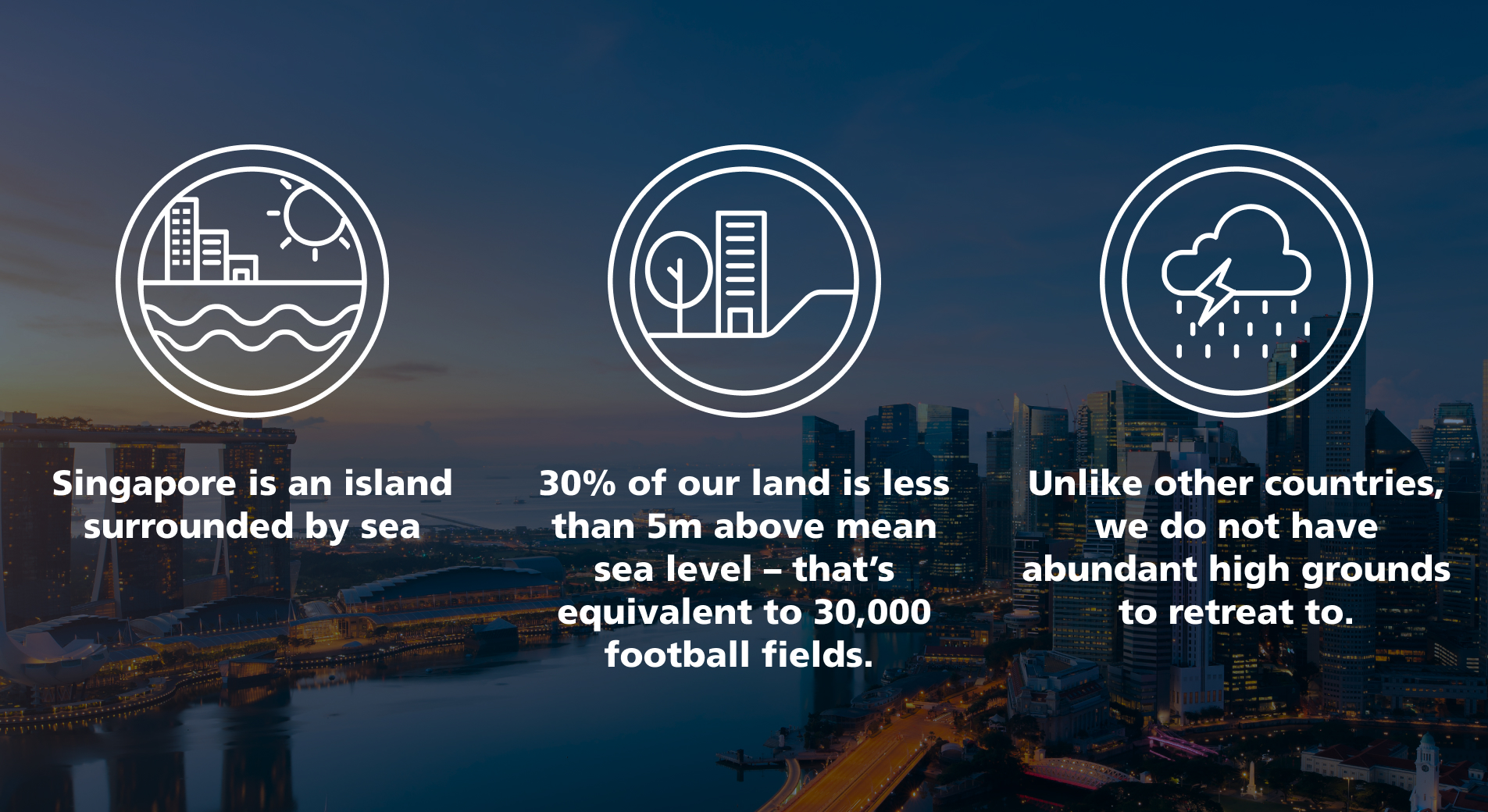
With climate change causing sea level rise globally, it’s important for an island city like Singapore to plan ahead and reimagine our coastlines, so we can keep our shores and our people safe.
In April 2020, PUB was appointed the national coastal protection agency to lead, coordinate and explore whole-of-government efforts to protect Singapore’s coastlines. PUB’s mission, to resist rising seas, will see us working closely with government agencies, experts, the community and various stakeholders, including businesses and interest groups, to co-develop measures to protect Singapore from the threat of sea level rise.
What is Sea Level Rise?
Sea level rise is driven by climate change and global warming. As more greenhouse gases are released and trapped in our atmosphere, our planet heats up. This leads to the melting of polar ice caps and glaciers, which increases the amount of water in our oceans. As sea water warms, it also expands – further contributing to the rise in global sea levels.
Today, mean sea levels are rising at a rate of 3 to 4mm per year.
How high will sea level rise in Singapore?
Mean sea level around Singapore is projected to rise by up to 1.15m by 2100. Sea levels could rise up to 4m or 5m if we take into account the compounding effects of mean sea level rise of 1.15m and phenomena such as:
What makes Singapore vulnerable to sea level rise?

How will it affect you?
If we ignore climate change and the threat of sea level rise, Singaporeans could face devastating consequences in the future.
Key Considerations for Singapore's Coastal Protection Plans




What is PUB doing to resist rising seas?
To develop measures to protect Singapore from the threat of rising sea levels, here’s what
PUB has begun doing: PUB has commenced the development of the Coastal-Inland Flood Model in 2021 to assess flood risks holistically.
Studying engineering solutions with nature-based enhancements to hold back the rising seas. These include sea walls, earthen bunds, revetments and mangroves.
Carrying out site-specific studies for vulnerable areas, starting with City-East Coast, Jurong Island and the north-west coast of Singapore.
To future-proof Singapore against coastal and inland flooding due to the impacts of climate change, PUB has developed a national coastal protection masterplan underpinned by the following three approaches:
1. Holistic Risk Assessment
To strengthen Singapore’s overall resilience against climate change, there is a need to study the combined effects of inland and coastal flooding, and optimise inland and coastal adaptation measures. Hence, a Coastal Inland Flood Model will be developed to simulate flood events under the combined effects of higher sea levels and intense rainfall. The model serves fit-for-purpose uses ranging from adaptation planning to operations management. It will also enable PUB to understand flood risks holistically and allow continuous review of flood risks based on the latest available data.
2. Developing Adaptive and Flexible Pathways
With current climate science, the exact rate and magnitude of sea level rise remains uncertain. Nonetheless, it is imperative to start preparations now to formulate plans and implement them progressively as development of coastal protection measures requires long lead-time and substantial investment. To cater for uncertainties, PUB’s coastal protection strategies will have to be flexible to allow for adjustments according to new developments in climate science. Policy frameworks and planning parameters will also be established to guide the implementation of coastal protection measures. Through the use of adaptation pathways in PUB’s strategy, our coastal protection approach ensures adequate protection while retaining the ability to adapt to changes in climate projections.
3. Integrated Planning
PUB will progressively carry out conceptual design of coastal adaptation measures for the various segments of our coastlines. When doing so, we will explore opportunities for value creation and develop innovative solutions that are multi-functional, integrated with land use and development plans, as well as enhance the natural environment. Stakeholder groups, such as the nature groups and community, will be engaged to seek feedback on the proposed coastal protection measures.

With climate change causing sea level rise globally, it’s important for an island city like Singapore to plan ahead and reimagine our coastlines, so we can keep our shores and our people safe.
In April 2020, PUB was appointed the national coastal protection agency to lead, coordinate and explore whole-of-government efforts to protect Singapore’s coastlines. PUB’s mission, to resist rising seas, will see us working closely with government agencies, experts, the community and various stakeholders, including businesses and interest groups, to co-develop measures to protect Singapore from the threat of sea level rise.
What is Sea Level Rise?
Sea level rise is driven by climate change and global warming. As more greenhouse gases are released and trapped in our atmosphere, our planet heats up. This leads to the melting of polar ice caps and glaciers, which increases the amount of water in our oceans. As sea water warms, it also expands – further contributing to the rise in global sea levels.
Today, mean sea levels are rising at a rate of 3 to 4mm per year.
How high will sea level rise in Singapore?
Mean sea level around Singapore is projected to rise by up to 1.15m by 2100. Sea levels could rise up to 4m or 5m if we take into account the compounding effects of mean sea level rise of 1.15m and phenomena such as:
What makes Singapore vulnerable to sea level rise?

How will it affect you?
If we ignore climate change and the threat of sea level rise, Singaporeans could face devastating consequences in the future.
Key Considerations for Singapore's Coastal Protection Plans




What is PUB doing to resist rising seas?
To develop measures to protect Singapore from the threat of rising sea levels, here’s what
PUB has begun doing: PUB has commenced the development of the Coastal-Inland Flood Model in 2021 to assess flood risks holistically.
Studying engineering solutions with nature-based enhancements to hold back the rising seas. These include sea walls, earthen bunds, revetments and mangroves.
Carrying out site-specific studies for vulnerable areas, starting with City-East Coast, Jurong Island and the north-west coast of Singapore.
To future-proof Singapore against coastal and inland flooding due to the impacts of climate change, PUB has developed a national coastal protection masterplan underpinned by the following three approaches:
1. Holistic Risk Assessment
To strengthen Singapore’s overall resilience against climate change, there is a need to study the combined effects of inland and coastal flooding, and optimise inland and coastal adaptation measures. Hence, a Coastal Inland Flood Model will be developed to simulate flood events under the combined effects of higher sea levels and intense rainfall. The model serves fit-for-purpose uses ranging from adaptation planning to operations management. It will also enable PUB to understand flood risks holistically and allow continuous review of flood risks based on the latest available data.
2. Developing Adaptive and Flexible Pathways
With current climate science, the exact rate and magnitude of sea level rise remains uncertain. Nonetheless, it is imperative to start preparations now to formulate plans and implement them progressively as development of coastal protection measures requires long lead-time and substantial investment. To cater for uncertainties, PUB’s coastal protection strategies will have to be flexible to allow for adjustments according to new developments in climate science. Policy frameworks and planning parameters will also be established to guide the implementation of coastal protection measures. Through the use of adaptation pathways in PUB’s strategy, our coastal protection approach ensures adequate protection while retaining the ability to adapt to changes in climate projections.
3. Integrated Planning
PUB will progressively carry out conceptual design of coastal adaptation measures for the various segments of our coastlines. When doing so, we will explore opportunities for value creation and develop innovative solutions that are multi-functional, integrated with land use and development plans, as well as enhance the natural environment. Stakeholder groups, such as the nature groups and community, will be engaged to seek feedback on the proposed coastal protection measures.